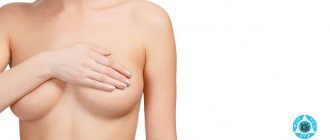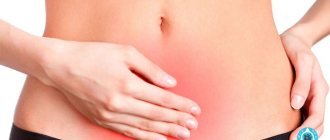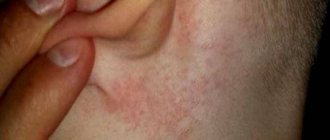A food allergy is a condition where the body reacts to a certain food as if it were a harmful substance. Both children and adults suffer from food allergies. But while a child’s allergy to any product may go away with age, an adult’s allergy, unfortunately, remains.
How do food allergies manifest? What foods to exclude from the menu to prevent an allergic reaction? How to treat food allergies? Let's try to answer these and other questions...
The most common allergens
Products that most often cause food allergies:
- eggs;
- nuts (hazelnuts, almonds, peanuts, etc.);
- fish;
- citrus fruits (oranges, tangerines, etc.);
- berries (strawberries, wild strawberries, etc.);
- chocolate;
- milk;
- legumes (soybeans, beans, peas, etc.).
- nutritional supplements.
Allergens found in some foods may be similar to pollen allergens. This is called cross allergy. For example, wormwood pollen is a cross-allergen for peppers, carrots, mustard, bananas, and citrus fruits. This means that a patient with hay fever may also have food allergies.
Allergy and Enterosgel
In the development of allergies, the key factor is the contact of the allergen (some substance in the air, food, clothing, etc.) with the body. Accordingly, minimizing or eliminating such contact prevents the development of the reaction, which explains the effectiveness of Enterosgel.
It is known that the intestines play a critical role in the functioning of the immune system. Enterosgel removes allergens from the gastrointestinal tract. In addition, Enterosgel removes bacterial endotoxins, promotes the regeneration of damaged mucosa and normalizes the intestinal microflora.
Thus, the functioning of the intestines and immune system is restored, and allergic manifestations are reduced. At the first signs of a possible allergy, you can take Enterosgel in a standard dose. Then use the drug according to the instructions for 1-2 weeks.
Need to know
The body's rapid and violent reaction to a food allergen is called anaphylaxis (anaphylactic shock). As a rule, anaphylaxis manifests itself 1-2 hours after the food allergen enters the body. It causes the tongue and throat to swell, breathing becomes difficult to the point of suffocation, vomiting occurs, blood pressure decreases, and the person loses consciousness. If you suspect anaphylactic shock, call an ambulance immediately!
In recent years, food allergies have become quite common. The most severe allergic reaction occurs to peanuts. Scientists conducted a study in which genes “responsible” for food allergies were found and studied. In 20% of cases it is a peanut allergy!
Drug allergies - symptoms and treatment
Allergies to medications can occur in any part of the body and in any organ. Symptoms range in severity from minimal discomfort to life-threatening conditions, and their duration ranges from minutes to weeks or months.
There are three groups of drug allergy symptoms :
- manifestations that occur in the first minutes or within an hour after administration of the drug - acute urticaria, anaphylactic shock, bronchospasm, angioedema;
- allergic reactions of the subacute type, developing up to 24 hours after using the drug - maculopapular exanthema, fever, thrombocytopenia, agranulocytosis;
- symptoms that develop within a few days or weeks after using the medicine - serum sickness, damage to internal organs, lymphadenopathy, vasculitis, arthralgia.
The most common manifestations of drug allergies:
- urticaria - the appearance on the skin of the body and face of rash elements from small pale pink to large spots of bright pink or even burgundy color, occupying almost the entire area of the body (a distinctive feature is the itching of these elements);
- increased temperature due to rashes (not always);
- swelling of the face or eyelids (most often asymmetrical);
- damage to the upper respiratory tract (bronchospasm).
With drug allergies, various disorders are possible:
- systemic (affecting the entire body);
- localized:
- skin lesions;
- damage to other organs and systems.[11]
SYSTEMIC LESIONS
Anaphylaxis is a serious life-threatening systemic hypersensitivity reaction. It occurs literally a few minutes or hours after the penetration of the allergen.
Anaphylaxis is indicated by the occurrence of two or more of the following symptoms:
- widespread urticaria on the skin and/or mucous membranes, which is accompanied by itching and/or redness, swelling of the lips, tongue or uvula;
- coughing, sneezing, nasal congestion, wheezing in the chest, shortness of breath, difficulty breathing (sometimes with noise and whistling) and, as a result, hypoxemia (lack of oxygen in the blood);
- a sharp drop in blood pressure (BP), loss of consciousness, sphincter paralysis;
- changes in the digestive system - cramping abdominal pain and vomiting.
Another variant of the course of anaphylaxis is an acute isolated decrease in blood pressure, which also occurs a few minutes or hours after taking the allergen drug. Systolic (upper) blood pressure in adults drops below 90 mm Hg. Art. or more than 30% of the initial pressure. The level of blood pressure in children and its reduction depends on age.
Quite often, similar symptoms may indicate non-allergic anaphylaxis. Its treatment is also no different from the relief of allergic anaphylaxis. The only difference is that true anaphylactic shock is much more severe and the risk of mortality is higher.
Acute severe widespread dermatoses:
- Exudative erythema multiforme (EME) is a rash of various shapes, represented by focal redness and “target-shaped” papules, which can develop into vesicles and bullae (bubbles), as well as erosion. The rash usually occurs on the skin of the hands, feet, genitals and mucous membranes.
- Stevens-Johnson syndrome (SJS) is a severe form of MEE that affects not only the skin and mucous membranes, but also internal organs. The area of allergic rashes on the skin occupies no more than 10%. Accompanied by fever and malaise.
- Toxic epidermal necrolysis (Lyell's syndrome) is a severe allergic reaction, life-threatening, manifested by widespread damage to the skin and mucous membrane (more than 30% of the surface), peeling of the skin, severe intoxication and impaired functioning of all organs. This condition is often preceded by MEE and SSD.[2]
Serum sickness is an allergic reaction that lasts several days or weeks. Occurs after the administration of heterologous serums and the use of penicillins, cytostatics, sulfonamides (antimicrobial drugs) and NSAIDs. The first manifestations occur 1-3 weeks after the start of treatment. These include: rash, fever, pain in large joints and swollen lymph nodes. Less commonly, allergies are accompanied by Guillain-Barré syndrome, glomerulonephritis (damage to the glomeruli), damage to peripheral nerves and systemic vasculitis.
Systemic drug-induced vasculitis is an allergic reaction in which a symmetrical hemorrhagic rash appears on the skin of the lower extremities and sacrum. At the same time, fever, malaise, muscle pain and anorexia appear. In more severe cases, the joints, kidneys and gastrointestinal tract are affected. In rare cases, infiltrates (accumulations of blood and lymph) appear in the lungs, and the functioning of nerve fibers is disrupted (manifested by muscle weakness and pain in the affected area of the body).
Drug-induced lupus syndrome is an allergic reaction, the symptoms of which are similar to those of systemic lupus erythematosus. The difference is the absence of a “butterfly” on the cheeks (extremely rare). The course of such an allergy is favorable. It can manifest itself as pain in the joints and muscles with an increase in the size of the liver and impaired renal function (glomerulonephritis). After discontinuation of the allergen drug, the patient's condition improves after a few days or weeks.
Drug fever is an undesirable reaction that differs from other fevers by maintaining relatively good health despite high fever and stunning chills. It disappears 2-3 days after stopping the allergen medication, but if it is used again, it appears after a few hours.
Drug hypersensitivity syndrome (DRESS) is a potentially life-threatening reaction to drugs that causes skin rash and fever, enlarged lymph nodes, hepatitis and other systemic lesions, and increased levels of white blood cells and eosinophils in the blood. The listed symptoms can develop from one week to three months and last about several weeks even after discontinuation of the allergen drug.
SKIN LESIONS
Maculopapular rash is an itchy rash that suddenly appears 7-10 days after starting the medication. Occurs mainly on the torso. May develop into Stevens-Johnson syndrome and Lyell's syndrome. Triggering drugs: penicillins, NSAIDs, sulfonamides and anticonvulsants.
Urticaria - single or multiple blisters of various sizes and locations, capable of merging and accompanied by angioedema. As a rule, the rash disappears without a trace. Provoking drugs : NSAIDs, ACE inhibitors, radiopaque (iodine-containing) substances, B vitamins, narcotic analgesics, sulfonamides, penicillins and other antibiotics.
Angioedema is a painless swelling of various localizations with clear boundaries that is painless to the touch, which is sometimes accompanied by a rash like urticaria and itchy skin.
Allergic vasculitis is an inflammation of the vascular walls, which is accompanied by symmetrical rashes in the form of small hemorrhages on the skin of the legs (usually in the lower third), buttocks and arms. At the same time, the skin of the face and neck remains unchanged. Provoking drugs: sulfonamides, barbiturates, gold salts and iodine-containing drugs.
Allergic contact dermatitis is an allergic skin lesion that occurs at the site of drug exposure, which is manifested by erythema, edema, and sometimes the appearance of vesicles and bullae. In some cases, inflammation may spread to an area of skin that has not been in contact with the drug. Provoking drugs: neomycin, chloramphenicol, sulfonamides, benzocaine, penicillin and other antibiotics.
Fixed erythema is an inflammatory allergic rash in the form of erythema, bullae or edematous plaques of various sizes with clear ridges. It may occur again even after apparent improvement. Two hours after repeated use of the causative drug, the rash appears in exactly the same place and persists for approximately 2-3 weeks, leaving chronic post-inflammatory pigmentation. Provoking drugs: tetracyclines, barbiturates, sulfonamides and NSAIDs.
Photodermatitis is an allergic rash in the form of redness that occurs on open areas of the body, sometimes accompanied by the appearance of vesicles and bullae. Provoking agents: topical drugs, including halogenated phenolic compounds added to soap, aromatic substances, NSAIDs, sulfonamides and phenothiazines.
The Arthus-Sakharov phenomenon is a local allergy in the form of an infiltrate, abscess or fistula, which appears 7-9 days or 1-2 months after contact with the drug. Provoking drugs: heterologous serums and antibiotics, as well as insulin (1-2 months after its administration).
Exfoliative erythroderma is a life-threatening common skin lesion (occupies more than 50% of its surface), represented by redness, infiltration and extensive peeling. Provoking agents: arsenic, mercury and gold preparations, penicillins, sulfonamides and barbiturates.
Erythema nodosum is an allergic reaction in the form of symmetrical and painful when touched subcutaneous red nodes of different sizes, which usually occur on the front surface of the legs. May be accompanied by a slight increase in temperature, malaise, pain in muscles and joints. Provoking agents: sulfonamides, oral contraceptives, penicillins, barbiturates, bromine and iodine preparations.
Acute generalized exanthematous pustulosis is an allergic skin reaction in which pustular rashes appear against a background of redness. It occurs with an increase in temperature to 38°C and the number of leukocytes in the blood. Disappears 10-15 days after discontinuation of the allergen medication. Provoking drugs: calcium channel blockers (diltiazem), sulfonamides, aminopenicillins (ampicillin, amoxicillin) and macrolides.
DAMAGES TO OTHER ORGANS AND SYSTEMS
In addition to the listed clinical manifestations, drug allergies may cause:
- damage to the respiratory system - rhinitis, bronchospasm, inflammation of the lungs and the formation of an eosinophilic infiltrate in it (Leffler's syndrome) - due to allergies to pyrazolones, carbamazepine, acetylsalicylic acid and other NSAIDs, ACE inhibitors, beta-blockers, penicillins and sulfonamides;
- lesions of the hematopoietic system - hemolytic anemia and thrombocytopenia - in response to taking streptomycin, quinidine, rifampicin, penicillin, ibuprofen and other sulfonamides, sulfonylurea derivatives, thiazide diuretics and gold salts;
- damage to the circulatory system - myocarditis (extremely rare) - when taking sulfonamide, penicillin and methyldopa;
- lesions of the gastrointestinal tract and hepatobiliary system - gastroenterocolitis, cholestasis, acute hepatitis, chronic hepatitis (rarely) - when taking pyrazolones, sulfasalazine, carbamazepine, allopurinol, sulfonamides, halothane, isoniazid and phenytoin;
- lesions of the urinary system (extremely rare) - acute interstitial nephritis and glomerulonephritis - a consequence of the body’s reaction to gold salts, NSAIDs, heroin, captopril, sulfonamides, penicillamine, penicillins and other β-lactams, rifampicin, ciprofloxacin and allopurinol;
- lesions of the nervous system - peripheral neuritis - reaction to gold salts and sulfonamides.
What a hello, what a response
An allergic response to any food component depends on our immune system and hereditary predisposition. Immune cells produce antibodies in response to the introduction of an allergen into the body.
The reasons for the development of allergies may be associated with the action of negative factors (for example, air pollution from exhaust gases or industrial waste). Food allergies to certain foods can be a consequence of problems in early childhood. For example, early refusal of breastfeeding, improper introduction of complementary foods, feeding with foods containing excess dyes, preservatives and other “chemicals”. It’s even worse if a breastfeeding mother does not keep a food diary - in this case, it is much more difficult to figure out what exactly caused the child’s allergies. As a result, the child develops diathesis - allergies on the face, skin of the neck, and limbs.
Interesting fact
After many years of observations, Japanese pediatricians found that first-born children suffer from allergies more often than younger children. Unfortunately, there is no scientific explanation for this phenomenon yet.
Most immunologists are confident that allergies are an “erroneous” reaction of the body to substances that are harmless to other people. Some adhere to a radically opposite theory, arguing that it is allergies that protect the body from foreign substances, for example, xenobiotics. According to this theory, in the process of evolution, allergic reactions developed in response to the emergence of a large number of new substances in the world around us. Perhaps, in this way, if you are allergic to plant pollen, the body warns its owner about their toxicity?
From this position, allergic reactions even benefit the body - a person avoids contact with allergens in the future and reduces their harmful effects on health. Do not forget that the line between benefit and harm is sometimes very thin. By consuming substances that are harmful to yourself and thus provoking signs of food allergies, you can bring the body into anaphylactic shock!
However…
British scientists have found that for 20% of their compatriots, food allergies are just a fiction that justifies laziness, excess weight, rashes on the body, and reluctance to eat right or exercise. In fact, only 2% of them have a food allergy (ICD 10 code - T78.1).
Sun allergy
Itching, redness, nodules or blisters on the body a few hours after exposure to the sun - an allergy or a manifestation of polymorphic photodermatosis.
The most common form of sun allergy is polymorphic photodermatosis.
More than 20% of the world's population suffers from this problem.
More often, women and children are susceptible to allergies (even more often, people with fair skin types).
The exact causes of sun allergies on the body are not clear.
It is only known that UV is a trigger and is considered as a trigger.
Another theory is that sunlight creates aggressive oxygen compounds (free radicals) in the skin, which cause sun allergies.
They can damage epithelial cells and increase the risk of developing skin cancer.
These same radicals can activate the immune system and lead to symptoms of polymorphic photodermatosis.
However, this assumption has not yet been scientifically proven.
Classic allergy on the body in adults and children is manifested by the following clinical picture and symptoms of solar allergy:
- The skin begins to itch and a burning sensation appears.
- The skin changes color and the formation of red spots (redness of the skin) is observed.
- Blisters, nodules, and papular formations appear. The skin may swell during severe inflammation.
In most cases, sun allergy symptoms occur when the skin is not exposed to sunlight for a long time.
Therefore, in spring, as well as during the beach season, sun allergies are most common.
Types of food allergies
Based on time and nature, the following forms of manifestation of food allergies are distinguished:
- Sudden - when consuming a product that has not previously caused an allergic reaction, numbness in the mouth, allergies on the face (in the form of redness of the skin), nasal congestion, swelling of the tongue suddenly appear;
- Persistent food allergies in adults, the symptoms and treatment of which we will consider a little later. This reaction occurs constantly in response to the consumption of prohibited foods and, if the diet is not followed, requires regular therapy;
- Hidden - the reaction does not occur immediately, but as antibodies accumulate to certain allergens.
- Severe food allergies. Symptoms occur immediately in response to the consumption of an allergen product.
Risk factors for food allergies in adults
Allergy symptoms and treatment depend on factors such as:
- nature of the allergen;
- age of the person at first contact with the allergen;
- other allergic reactions (eg, hay fever, contact allergy);
- diseases of the digestive system;
- type of contact with the allergen (first or repeated);
- state of intestinal microflora.
Hidden danger
If you are allergic to fish, never lick postage stamps when sending mail! The fact is that the reverse side of the stamp is covered with glue, which is made from fish bones. They licked it, stuck it on, and please - food allergies, allergies on the face, torso, limbs.
Food allergic reaction
Today, the following types of allergies are distinguished, which are accompanied by various clinical signs on the body.
A food allergy in the body is an immunologically mediated (type I/III) reaction to allergens that enter the body through food.
The most common triggers are cow's milk, fish, nuts, chicken eggs, cocoa, and food coloring added to sweets.
Symptoms of food allergies vary, but most often include rashes, red spots, hives, and itching of the skin (face and body).
In most cases, food allergies are accompanied by the development of urticaria (urticaria).
Urticaria (urticaria) is a skin disease, the main feature of which is itching and the development of rashes on the surface of the skin.
Triggers for aggressive skin reactions can be varied.
All people are susceptible to developing allergic urticaria, regardless of race or age.
In most cases, acute spontaneous urticaria is observed, which occurs completely suddenly and disappears after a few days.
Antihistamines and intestinal sorbents will help speed up the healing process.
If allergy symptoms on the body last longer than six weeks, we should talk about chronic urticaria.
Urticaria can be recognized by the following symptoms:
- It appears in the form of bright pink spots, up to 2 cm in diameter, sometimes more. The spots do not have a clear shape and can merge into larger lesions.
- The localization of spots can change, migrating from one area of the skin to another. Also, allergies can spread throughout the body, both in adults and children.
- It appears suddenly, a few minutes or an hour after contact with the allergen, and can also disappear suddenly.
If we are talking about chronic urticaria, then the skin manifestations of the reaction are complemented by a deterioration in general health, fever, and signs of asthma.
Quite rarely, sudden and painful swelling of the deeper layers of the skin (lower dermis and subcutaneous layer), called angioedema, may occur.
This allergy can cause swelling and itching of the entire body.
A few words about our smaller brothers
It turns out that animals also suffer from food allergens. For example, food allergies in cats occur regardless of gender, breed and age. The main signs are itchy skin, hair loss, scratching on the skin.
Most often, food allergies in cats occur to soy, gluten, seafood, beef, dairy products, and lamb.
In its manifestations, food allergies in purebred dogs are no different from food allergies in dogs – “ mongrels”:
- itching, pimples on the scalp, abdomen, paws;
- discharge from the eyes, nose, ears.
But let's go back to the representatives of the species Homo Sapiens, or, more simply, to people.
What are the symptoms of food allergies in adults?
More often, an immediate response from the body occurs immediately after consuming the allergen product. Sometimes (although less frequently) symptoms appear after several hours or days.
What does a food allergy look like:
- numbness and swelling of the tongue, lips and oral mucosa;
- itching of the skin and oral mucosa;
- difficulty swallowing;
- acne on the skin;
- clear nasal discharge;
- nausea, vomiting;
- allergy on the face in the form of redness;
- sneezing, dry cough;
- colic in the stomach,
- diarrhea (diarrhea).
What factors determine food allergies in adults? Symptoms and treatment of the disease depend on concomitant diseases. For example, scientists have proven a direct connection between food allergies and... diabetes. It turns out that food allergies provoke inflammation in the pancreas and tissue resistance to insulin.
Possible causes of itchy body skin: which doctor to consult
Itchy skin is an unpleasant sensation accompanied by the need for mechanical irritation of the skin, that is, it causes a constant desire to scratch the disturbing area. The types of skin itching depend on the reasons that provoked it. Itching is a symptom of various diseases, disorders and conditions. It can be the result of infection, inflammation, allergies, insect bites, or occur during the normal wound healing process. Itching significantly affects the general condition and quality of life of patients. It causes insomnia and, in severe cases, leads to depression.
What about the children?
Food allergies in a child are a serious problem. Therefore, the main task of parents is to quickly identify the product that causes the allergy and exclude it from the baby’s diet. Food allergies in infants, like food allergies in children 2 years of age and older, are manifested by various rashes: nodules, blisters, pink or red spots. The allergy is located on the face, neck, skin of the extensor surfaces of the joints, torso, buttocks, and itchy skin. The baby eats poorly, sleeps poorly, becomes capricious and restless.
By the way, the statement that a child may be allergic to mother’s milk is nothing more than a myth! Most likely, the baby’s body reacts to allergens that enter the mother’s milk along with food: perhaps the mother ate an egg, fish, chocolate or peanuts the day before...
Various congenital diseases associated with metabolic disorders, for example, phenylketonuria, can also disguise themselves as symptoms of food allergies in children. With such diseases, the body is not able to absorb certain substances - proteins, carbohydrates, etc. The diagnosis can be made through a series of biochemical and genetic studies.
Causes of itchy skin
Itching of the scalp
Caused by diseases of the hair and scalp. It is accompanied by a feeling of skin tightness, scaly desquamation of the epidermis (dandruff), increased oiliness of the hair, excess sebum production, fragility, and sometimes hair loss. Itchy scalp can be caused by incorrectly selected care and styling products (shampoo, conditioner, hairspray). The most common pathological causes of itchy scalp include:
- pathology of the sebaceous glands: dandruff, seborrhea (oily, dry, mixed);
- parasitic diseases: head lice, demodicosis, flea bites, bedbugs;
- mycoses: favus, trichophytosis, microsporia;
- hair shaft abnormalities: idiopathic trichoclasia, knotty hair;
- autoimmune pathologies: psoriasis, SLE, scleroderma;
- other dermatoses: pityriasis versicolor pilaris (Devergie's disease), allergic dermatitis of the scalp;
- general diseases: hypovitaminosis A, heavy metal intoxication, hypothyroidism.
Itchy skin
Body itching
The causes of skin itching can be dermatological and systemic diseases. In some cases, body itching is caused by simple lack of personal hygiene: rarely taking a bath or shower, wearing dirty clothes. On the other hand, itchy skin can occur with infectious and parasitic dermatoses that are contagious to others. Itchy dermatoses are often found in older people (senile itching) and pregnant women. Dermatological diseases that most often cause itchy skin include:
- inflammatory lesions: prickly heat, seborrheic dermatitis, eczema, lichen planus, acne;
- skin infections: herpes, pyoderma, folliculitis, dermatophytosis;
- acariases and entomosis: scabies, demodicosis, pediculosis, insect allergy;
- chronic autoimmune dermatoses: psoriasis, dermatomyositis, Dühring's dermatitis herpetiformis, pemphigoid, pemphigus vulgaris;
- allergic dermatoses: urticaria, prurigo, allergic contact dermatitis, neurodermatitis;
- genodermatoses: ichthyosis, Darier's disease, Haley-Hailey disease;
- skin tumors: leukemides, Sezary syndrome, mycosis fungoides and other T-cell lymphomas of the skin.
Itching of the whole body can be a side effect of taking certain drugs: ACE inhibitors, anti-gout, antiarrhythmics, hormonal drugs, opioids. Systemic diseases occurring with chronic skin itching:
- endocrinopathies: diabetes, hypothyroidism, thyrotoxicosis;
- diseases of the hepatobiliary system and kidneys: cholestasis, cirrhosis of the liver, chronic hepatitis, chronic renal failure;
- infections: HIV, helminthiasis;
- hematological diseases: mastocytosis, leukemia, polycythemia, myeloma, lymphogranulomatosis;
- mental disorders: OCD, depression, dermatozoal delirium.
Itching in the eye area
My eyelids can itch due to any of the listed skin, infectious and general somatic pathologies. However, more often the causes of itching in the eyes are ophthalmological diseases and visual strain. People who use contact lenses, work in contact with dust and chemicals without proper eye protection, and patients with allergies and immunodeficiencies are at risk of developing such a problem. Causes of itchy eyes:
- injuries: foreign bodies, burns, mechanical damage;
- inflammatory diseases: blepharitis, conjunctivitis, meibomitis, barley, keratitis;
- parasitic lesions: demodicosis, dirofilariasis;
- allergies: eyelid dermatitis, hay fever;
- other eye diseases: dry eye syndrome, computer vision syndrome, glaucoma, cataracts.
Food allergies: diagnosis
The diagnosis of “food allergy” is made by a doctor based on a survey of the patient or his relatives (the connection between the symptoms of food allergy and the consumption of a certain product), examination and laboratory test data.
Skin tests are performed. A small amount of liquid that contains the allergen is applied to the skin, after which a small injection or incision is made. If the skin swells at the injection site, like after a mosquito bite, this indicates an allergic reaction, and the size of the rash indicates the strength of the reaction. In addition, immunological tests for food allergies and special tests are carried out.
Cold allergy
Cold urticaria is a rare disease that occurs in approximately 2-3% of cases.
The reaction is caused by cooling of the skin or mucous membranes upon contact with air, water, cold objects or frozen foods.
Cold urticaria appears quickly.
Accompanied by progressive itching, erythema (redness) and swelling of the skin after contact with cooled substances.
Sometimes, the first symptom is a burning sensation of the skin.
Clinical signs occur mainly in areas that have been exposed to cold.
But sometimes they can spread throughout the body.
Symptoms usually go away on their own after a few hours or a few days.
Allergy to cold with typical symptoms on the body manifests itself during exposure to the following factors:
- Low air temperature, cold wind, rain.
- Staying in cool water or walking barefoot on a cold floor.
- Drinking cold drinks and food.
The diagnosis of cold urticaria is made based on the results of the anamnesis and diagnostics.
To confirm the reaction, a test is carried out using an ice cube.
The test is performed by placing ice wrapped in a plastic bag on the forearm for 5-20 minutes.
The test is considered positive when symptoms develop within 15 minutes after the start or end of testing.
It's worth noting that about 20% of people with cold urticaria have a negative ice cube test.
How to cure food allergies?
Treatment of food allergies is aimed at reducing the symptoms of an allergic reaction, removing the allergen from the body and restoring the intestinal microflora. Accelerates the elimination of toxic products of an allergic reaction by taking sorbents - most often this is the familiar Enterosgel.
In addition, antihistamines are prescribed, and in severe allergies, glucocorticoid hormones.
After identifying the cause of the allergy, a strict hypoallergenic diet is prescribed.
A diet for food allergies involves a complete rejection of foods containing the allergen, as well as smoked foods, marinades and alcoholic beverages. The products are consumed boiled or stewed. What then can a child and an adult do? Casseroles, vegetable soups, cereals, unsweetened tea, crackers, herbal infusions.
This is interesting
Did you know that allergies are afraid of fermented milk products? According to Thai scientists, the best prevention of allergies is a glass of kefir once a day.
- Enterosgel sorbent helps well against allergies: as mentioned above, the drug safely binds and removes allergens, toxins and other harmful compounds from the body, thanks to its unique form, without affecting beneficial substances and microelements;
- For adults, pills for food allergies are selected by the attending physician, taking into account symptoms, concomitant diseases and the form of allergy, so you should not self-medicate. Long-acting antihistamines are considered effective drugs;
- Probiotic preparations protect the intestines and restore microflora;
- For severe forms of food allergies, for example, angioedema, hormonal medications are prescribed.
Treatment of food allergies in adults with folk remedies
To reduce signs of an allergic reaction, decoctions of medicinal herbs are suitable: chamomile, nettle, calendula. Baths with string, chamomile, and oat decoction will help relieve skin itching.
Specific immunotherapy offers effective treatment for food allergies in adults: the method is based on the regular administration of small doses of the allergen in order to reduce susceptibility to this substance. On average, treatment lasts from three to five years, but after the course of treatment the body stops reacting violently to the irritant, and the person gets rid of allergies.
Treatment of food allergies in children
Go to any forum dedicated to food allergies - there is always a lively discussion of the symptoms of food allergies in children, methods of treatment and prevention... But what do doctors say?
Strict adherence to the diet and proper care of the child will allow you to forget what food allergies are. Komarovsky believes that the first step is to get rid of allergens that have entered the blood, ensure regular bowel movements and remove allergens. Enterosgel effectively prevents the absorption of “harmful substances” and removes them from the body. In addition, the doctor does not recommend overloading the child with food.
Prevention
The patient’s main task is to completely eliminate dangerous foods from his menu! With this reasonable approach, the risk of nutritional (food) allergies will be minimized.
Doctors recommend keeping a food diary, which makes it easier to detect the “enemy.” In it, parents should write down everything that their child eats during the day, or everything that the nursing mother ate. Along with the food, the baby’s condition is noted in the diary.
A big mistake would be to refuse breastfeeding due to a nutritional allergy in a child - after all, the unique properties of mother's milk will allow you to quickly cope with the problem. But a nursing mother must adhere to a strict diet, avoiding foods from the “allergenic list.”
In addition, it would be useful to strengthen the immune system, prevent dysbiosis, and timely treatment of exacerbations of chronic diseases or acute viral infections.
Do not forget that food allergies often originate in childhood. For example, a food allergy in a 2-year-old child may eventually manifest itself in adulthood as Quincke's edema.
Alcoholic beverages aggravate food allergy symptoms in adults, so it is advisable to avoid alcohol.
It is important to know!
- Thanks to comprehensive treatment of food allergies, rapid recovery occurs;
- in the future, the patient should avoid foods that cause an allergic reaction;
- if your child has a food allergy, be sure to notify the preschool or school staff about this, and, if possible, document this fact;
- make sure your child wears a special allergy bracelet;
- If your child has previously had an acute allergic reaction, you should always have a first aid kit with an antihistamine and epinephrine (adrenaline). At the first sign of an acute reaction, it is necessary to give the child these medications and call an ambulance.
Be healthy!
Treatment
Help before diagnosis
If the burning sensation is caused by a slight burn of the skin (only redness, no blisters), it can be treated with dexpanthenol sprays. Medicines quickly relieve symptoms, soothe the skin and promote its healing. If you experience severe burns, rashes or other symptoms, consult a doctor. To quickly relieve burning sensations, experts prescribe gels and sprays with a soothing and cooling effect.
Conservative therapy
Therapy is determined by the underlying disease. Often, burning skin is caused by dermatological pathologies, to eliminate which an integrated approach is practiced. For mild cases of the disease, local remedies are sufficient: lotions and wet-dry dressings for weeping, ointments and rich creams for peeling. They use medications with antiseptics and antibiotics, topical steroids, and antimycotics.
For allergic dermatoses, systemic detoxification therapy is prescribed: antihistamines, sedatives, methods of extracorporeal hemocorrection. Antifungal drugs in tablets are recommended for the treatment of common mycoses. Herpes zoster requires intravenous or oral acyclovir.
Physiotherapy methods are effective in a comprehensive treatment regimen. To eliminate rashes, accelerate skin healing and stimulate immune defense, laser therapy, magnetic therapy, and ozone therapy are prescribed. In the remission phase of chronic dermatoses, skin irradiation with ultraviolet light and mud therapy are used. With senestopathies, patients require the help of a psychiatrist.









